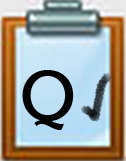Q2 That Didn't Work. Now What? Steps
Steps
1. Create three flowcharts (Troubleshooting Flowchart worksheet - your teacher may have you use this worksheet to submit your work) using a graphic organizer (For ideas for graphic organizers use (Thing 2.Q1.) to show your steps for the following problems)
-
Problem One - Murphy is moving the mouse on her desktop computer and nothing happens. The keyboard is working, but not the mouse. List all of the possibilities in flowchart form on how she would troubleshoot the problem.
-
Problem Two - Murphy is using an application on a Windows computer and it stops responding and is frozen. List all of the possibilities in flowchart form and how she would troubleshoot the problem.
-
Problem Three - Murphy tries to use the family computer. She pushes the power button on the computer, hears the fan turn on, and sees the indicator lights… but there is nothing on the LCD monitor. List the possibilities of what is wrong in flowchart form, and describe the steps you would take to eliminate the problem.
Competencies & Standards
MITECS Michigan Integrated Technology Competencies for Students, and
1. Empowered Learner
a. Articulate and set personal learning goals, developing strategies leveraging technology to achieve them, and reflect on the learning process itself to improve learning outcomes
c. Use technology to seek feedback that informs and improves their practice and to demonstrate their learning in a variety of ways
d. Understand the fundamental concepts of technology operations, demonstrate the ability to choose, use and troubleshoot current technologies, are able to transfer their knowledge to explore emerging technologies
5. Computational Thinker
c. Break problems into component parts, extract key information and develop descriptive models to understand complex systems or facilitate problem solving
6. Creative Communicator
a. Choose the appropriate platforms and tools for meeting the desired objectives of their creation or communication
c. Communicate complex ideas clearly and effectively by creating or using a variety of digital objects such as visualizations, models or simulations
Websites and Documents
21t4s Videos
21t4s Websites
21t4s Documents & Quizzes
- Troubleshooting Flowchart (worksheet)
- Vocabulary Quizlet




